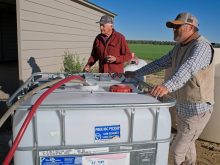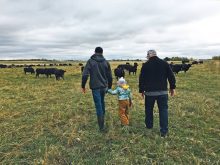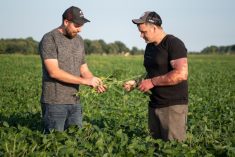There are a number of reasons why farmers might want to try their hand at organic farming. Reports of premiums based on the demand for organic foods might be one. Cutting expensive chemical inputs out of your budget can also be a major incentive.
However, if you’re only looking at organic farming through a financial lens, you may have to look a bit deeper, says Swift Current, Sask., organic producer Garry Johnson. Organic farming requires a higher-than-average knowledge of the soil and plant ecosystems, he says, and you’ll also have to accept that your yields will likely lag behind those of conventional farmers. But if you do it right, it can be immensely rewarding.
Read Also

Cancer agency reclassifies another herbicide ‘probably carcinogenic’
The WHO’s cancer research agency has now put atrazine, a herbicide well known to corn growers, in the same potential-hazard category where the agency put glyphosate.
“A conventional farmer who is able to spray and use fertilizer will always have a yield advantage. Typically, yields are nice in the organic system but we’re mainly striving for quality versus quantity.”
There’s no doubt that not having commercial fertilizer, pesticides and herbicides in the budget can cut operational costs considerably. However, organic farmers have costs of their own, says Johnson, who has been an organic farmer for more than 20 years following a lifetime of conventional production.
“Invariably, as an organic farmer, you have a lot of other costs associated with our practices, although they may not reach the same level as a conventional farmer,” he says.
Organic farming in a nutshell
The processes behind organic agriculture are extremely complex, but Johnson explains it as simply as possible.
“We’re mimicking nature, supporting the system between plants and microbial activity in the soil. The plant exudes sugars out of its roots, which the microbial population will utilize. In turn, the microbes supply the plant with all they need in terms of minerals and nutrients. It’s a real symbiosis.”
Cover crops — including legumes — act as key tools in this process by fixing nitrogen in the soil, managing weeds and providing soil cover. Johnson uses either an oat-pea or oat-buckwheat mix for his cover crops, although he’s always on the lookout for new crops appropriate for his region.
“It’s important to have as many crops in your rotation as possible because it makes for better soil building,” he says.
Johnson doesn’t market his cover crops, instead terminating them in early summer to ensure optimal nitrogen fixation and minimize water usage.
A balancing act
Traditionally, one of the key practices required by most organic certifying bodies has been to leave the land fallow or planted in part to cover crops every second year. That, of course, means cash crops were only planted every other year on most fields.
This is an undeniable challenge for cash flow, says Johnson, whose goal is to use less fallow in favour of weed-killing, soil-building, cover crops. Including plenty of legumes in his cash crop rotation has helped open up his revenue opportunities, however.
“Since we’ve adopted a rotation that includes commercial crops with better soil-building capabilities such as lentils, chickpeas, peas and clover, we’ve been able to utilize more of our land base annually. We’re setting aside about a third of our farming acres for fallow or cover crops instead of half of it like we used to. It’s a balancing act, no doubt.”
Keep an eye under the ground
Continually monitoring the soil is crucial to organic farming. For Johnson, it can be as simple as keeping a shovel in his truck in order to gather snapshots of what’s going on under the ground.
“Tip the earth over a little bit every once in a while. Take a look at the root systems and the soil around the roots. Be attentive to possible soil erosion or deficiencies such as weed populations and disease — they may give you a signal as to what’s really happening in your soil.”
Be prepared for lender apprehension
One barrier anyone considering organic farming should be prepared for is lender apprehension.
“It becomes a challenge because most lenders really don’t have a good understanding of organic farming and principles. They just need a little help to understand how we do things,” says Johnson.
“I would say it’s taken us a number of years to build a really good relationship with our lending institution. They now understand how we farm and how we can make a living at it.”
Cattle complete the circle of life
If Johnson was to give aspiring organic producers a piece of advice today, it would be to keep livestock as part of the organic farming process.
“The benefit to the farmer is that cattle deposit nutrients wherever they go, so they are actually providing value to the soil while they are foraging. It’s a good synergy relationship.”
















